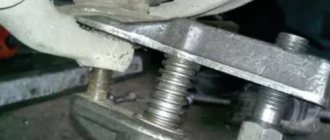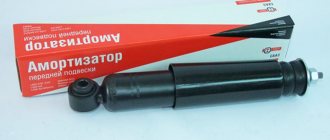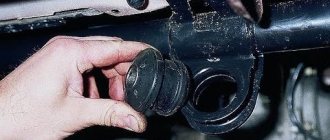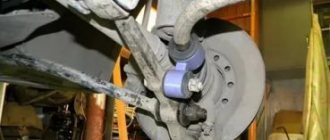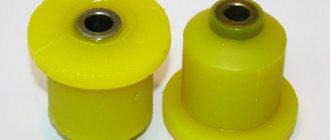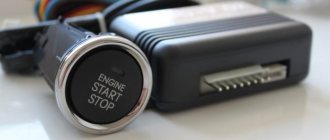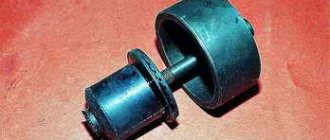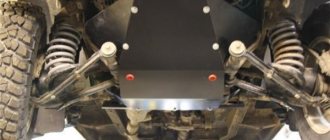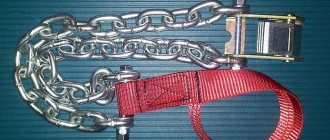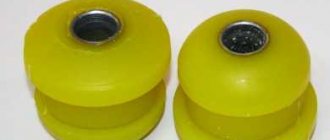What is a silent block?
The word “ silent block ” is of foreign origin; translated from English “silent” means silence and “block” means detail. A silent block or “silent” is a rubber-metal part; in other words, it is two bushings connected to each other by a thick layer of durable rubber. This invention, in addition to providing comfortable and silent movement in a car, has a number of advantages that I cannot list.
What are silent blocks needed for?
- Silent blocks prevent beatings and vibrations that occur during vehicle movement between various parts of the chassis and engine compartment.
- They protect parts from wear and tear by damping vibrations.
- They dampen vibrations coming from the wheels and chassis, thereby ensuring a soft and comfortable ride.
And these are just the main advantages of silent blocks; in fact, there are many more of them. However, today we will talk a little about something else, namely how to repair a car with your own hands, press out and press in silent blocks without damaging the part and your car.
When and why to change silent blocks?
Replacing silent blocks is most often done after the driver begins to notice a deterioration in the driving characteristics of his car or after the appearance of extraneous sounds (knocking, creaking, grinding), indicating the need to replace the silent blocks. Also, damaged silent blocks are often discovered during chassis diagnostics on a vibration stand.
If the silent blocks are not replaced on time, the owner risks even more breakdowns, which one way or another will arise due to faulty “silents”. For example, due to one damaged silent block, the load begins to be distributed unevenly, resulting in generation in other connections and nodes. As a result, instead of just one bushing, you will have to fork out money to replace all the silent blocks of the rear or front suspension.
Moreover, one should take into account the fact that a faulty suspension affects: a deterioration in the level of comfort, increased fuel consumption, increased tire wear, and also increases the braking distance, as a result of which the risk of an accident seriously increases.
What is a silent block
This word is of foreign origin. Translated from English, silent means silence, and block means detail. A silent block, or simply “silent,” is a rubber-metal component; in ordinary words, these are two bushings that are connected to each other by a layer of durable rubber. This invention, in addition to guaranteeing comfortable and silent movement in a car, has a number of advantages that will be listed below.
Purpose and functions
Silent blocks perform the following functions:
- Protect components from wear and tear by damping vibrations .
- They dampen vibrations that come from the chassis of the wheels, thus providing a comfortable and soft ride.
- Prevent vibrations and beatings that appear during the movement of the car between different elements of the chassis and engine compartment.
And these are just the main advantages; in fact, there are many more.
FORCE 949T1
The model belongs to the hydraulic puller type, the set of which includes 49 items. With its help, you can easily disassemble the bushing and replace it (with the exception of parts without holes). Compared to the above puller options, FORCE 949T1 is lighter and easier to use.
Characteristics:
- The maximum load on the cylinder is 18.2 t.
- The comfortable and durable spindle has dimensions: Ø 16 mm, Ø 14 mm, Ø 12 mm, Ø 10 mm.
- Deep mandrels - 22 pieces (18 internal ones of 110 mm each and 26 external ones of 68 mm each).
- Short mandrels - 22 pieces (18 internal 40 mm and 26 external 68 mm).
- Bolts - 4 pieces (diameter 16, 14, 12, 10 mm).
- Type - hydraulic universal puller.
Pros:
- Convenient collars.
- Sturdy case with metal clasps.
- Strong ratchets.
- Long heads.
- The handles are made of high-quality material that is not corroded by technical liquids.
Minuses:
- All parts of the puller are sensitive to moisture and quickly rust when exposed to it.
- High price.
How to understand when it's time to replace
Before you set out to press in these parts, you should first of all inspect them thoroughly to make sure that they really require replacement.
Check for holes and any deformations, for swollen rubber on the hinges and for cracks. Manipulate the components, determining the presence of backlashes. If the permissible norm is exceeded, then replacement of parts is inevitable. It is not recommended to delay the pressing procedure. Over time, this problem will only get worse and can lead to suspension arm failure. The main indicators that indicate the failure of one part or several:
- Driving the car has become much more difficult.
- When overcoming bumps, the suspension begins to knock loudly. Tires wear unevenly, which has not been observed before.
- It has become much more difficult to adjust wheel alignment.
What is a puller for installing silent blocks?
- Bolt with nut. The diameter and pitch of the thread are at your discretion. If the thread is small, you will have to turn it longer, but it will work easier and smoother.
- We select a cylinder with a diameter such that the silent block fits into it.
- Washers. Some. One washer should tightly cover the cylinder hole. You can even weld the washer on one side. We take the remaining washers with a smaller diameter than the diameter of the silent block.
A RC puller is needed not only for removal, but also for installation, so as not to damage the new silent blocks. And when removing with a puller, there is no need to hit with a hammer and there is no risk of damaging the paws (levers). If you knock out rubber-metal hinges with a hammer, microcracks may appear on the lever.
On cars with 4-link suspension, the wheel alignment angles may be disrupted if the levers or new silent blocks are damaged. In this case, you will have to change the rubber-metal bushings and, possibly, the wheels again.
In terms of cost, pullers for automobile silent blocks can be purchased at prices ranging from 800 rubles to 30,000 rubles (a set of different pullers). But it is easy to make from available materials.
The operating principle of a mechanical puller is that when the nut is tightened, the silent block itself is squeezed out of the lever eye. Hydraulic ones are more complex in design, they are more powerful, but it is better to buy them when necessary; it is impossible to make them from scrap materials.
Necessary materials
To press this part into place at home, you will need the following tools:
- Mount;
- Jack;
- Set of wrenches;
- New hinges.
It is recommended to use machine oil or other types of lubricant as a lubricant.
Among other things, you will need special mandrels designed for pressing silent blocks; as an alternative, you can use a piece of pipe with the required diameter. You also need to get a press to press in a new rubber-metal hinge . When it comes to home use, an ordinary vice can serve as a press. In addition, you can stock up on a set of sledgehammers, but with this approach it is necessary to maintain high precision in the work.
Licota ATC-2286
The set of silent block pullers is equipped with mandrels and cups of the most popular sizes, which are excellent for working with parts of domestic and foreign production.
Before using the puller, you only need to select a mandrel of the required size, install it on the element to be removed and perform dismantling by rotating the nut. Using the kit, the entire silent block removal process is quick and easy.
Read also: Methods for laying cables in the ground
Characteristics:
- It is used for both pressing out and pressing in silent blocks.
- Internal mandrels: 34, 36, 38 – 70, 72, 75, 80 mm.
- Outer mandrels: 44, 46, 48 – 80, 82, 85, 90 mm.
- Pins: M10, M12, M14, M16, M18.
- Type: universal puller.
- Weight: 17 kg.
Pros:
- It has different attachments, making it suitable for different brands of vehicles.
- All parts are easy to assemble and disassemble.
- Possibility of dismantling and installing silent blocks.
- Convenient case for storing all puller parts.
Minuses:
- Relatively heavy weight.
- High price.
Pressing out at home
Replacing these parts is not as difficult as it might seem at first glance. For example, many car owners made sure of this when they replaced parts, using special equipment for self-replacement. It is for this reason that there are many people who have decided to replace silent blocks with their own hands and at home.
First method
First of all, let's learn about how it should be ideally.
The lever in which the rubber-metal hinge needs to be replaced is installed on a special spacer for the press. The old silent will be squeezed onto this spacer. Then another spacer is installed on top - it squeezes out the old bushing. This method is used by service station workers, since they have the necessary set of spacers and a powerful press of 10-20 tons.
Second method
Almost all car owners, naturally, do not have a powerful press, but many have a jack or a good vice in their garage. If you use a powerful vice, you can successfully squeeze out the old bushings according to the principle that is already familiar to us: a spacer for the original bushing and a spacer for pressing on the bushing.
At first glance, it becomes unclear how you can squeeze out the silent tape with a jack? Everything is very simple: you need to weld a frame in the shape of a rectangle from a channel or corner so that its height is slightly higher than the lever and the jack. The operating principle is as follows: place the jack in the frame, then install the lever eye on top of the rod, as well as the two spacers mentioned above. We create the required pressure, after which the bushing is squeezed out of its seat. It must be emphasized that most often a jack with a capacity of 3-5 tons is not able to cope with such work, therefore it is recommended to use 10-ton jacks.
Third method
If you have neither a press nor a jack, but still have a strong desire to replace the silent blocks on your own, you can use the third method - using a simple press puller (bolt with nut or stud).
The principle of operation is to create pressure by gradually tightening the nut on the stud; this method can be called an analogue of a vice. This pin with a washer of suitable diameter is inserted into the eye through the silent block, then on the other side you should put on a spacer with a washer and tighten the nut. Rotating along the thread, the nut creates the necessary pressure and forces the silent to be squeezed into a special spacer.
This “method” requires the use of a strong, hardened stud and an equally strong nut. If you take a soft pin or nut, you will most likely fail. For example, there are cases when, due to strong pressure, the stud becomes bent, as a result of which the thread on the nut breaks. However, there are thousands of those who managed to change silent blocks using this particular method. After all, everything depends on the quality and strength of the material used.
JTC 1-4091
A universal kit for removing and installing silent blocks is an ideal tool for vehicle maintenance.
It includes 11 items that, in addition to the parts already mentioned, are suitable for installing and dismounting bushings or bearings (including those with a rubber bushing).
Characteristics:
- The inner diameter of the sleeves (20 pieces) is 34 – 72 mm in increments of 2 mm.
- Support discs used together with liners - 2 pieces.
- Bolts with a length of 450 mm - M16, M14, M12, M10.
- The weight of the set is 3.3 kg.
Pros:
- All elements are made of high strength steel.
- Supplied in a durable case, making it easy to care for and transport the set parts.
- Relatively light weight.
- Case strength.
Cons: No socket or ratchet to make the job easier.
Quite a lot of car enthusiasts are interested in how to make a silent block remover with their own hands. After all, these vibration-reducing suspension elements have to be changed quite often. Moreover, this applies not only to domestic cars, but also to many foreign cars. The problem is related to the poor quality of roads. A sporty driving style also negatively affects the technical condition of silent blocks as part of the suspension. Incorrect installation will not extend the service life.
Read also: Ferrous metal production cycle
Many mechanics hammer the silent block with a hammer. In this case, the rubber is damaged and the metal bushing may become dislodged. Therefore, always use pullers; as a last resort, there are completely harmless methods to put the part in place without the help of specialized tools. We will talk about this at the end of the article.
How to make a silent block remover with your own hands? Before answering this question, it is advisable to understand what a silent block is. This will make it easier to make a puller.
A silent block is a rubber-metal joint that is capable of dampening vibrations that occur in the suspension. On passenger cars, a part made in the form of a metal bushing with an elastomer body is more common. The most common option for making a hinge is regular rubber. But polypropylene hinges can be called the most durable and high-quality. It is recommended to purchase exactly these when replacing.
Pressing in silent blocks
We have already talked in detail about how to get the “silents”, now another problem arises - how to press this part? This procedure is difficult because it requires certain skills and abilities. An incorrectly or crookedly installed silent will either not work or break prematurely.
First method
As with pressing, pressing should ideally be done using a vice. The principle is somewhat similar, but just the opposite. Before pressing the part, you need to thoroughly clean the seat from any residues and rust from the previous silent using sandpaper. Then the eye is generously lubricated with a lubricant like “Litol” or with a soap solution. A lever is installed, the part is placed on top, after which press pressure is applied to the spacer through a special mandrel. It will press the part into the seat.
Second method
When you do not have a press, you can press the part using the above-mentioned jack or a vice. The principle of operation is no different from a press. The lever, bushing, and spacer are installed. Then, under the force of a vice or jack, the part is pressed into the seat.
Third method
Press puller. If the silent block is small, you can “put it in its place” using the same press puller that was used to press the part out of the socket. Again, the principle is the same, only a thick washer and a pin are used as a press.
Fourth method
Using a sledgehammer and brute force.
This method is not the best of all existing ones, since it is considered more from a purely theoretical point of view. In other words, it really allows you to press a part, but it’s very difficult to say what the results and quality of work will be. The principle is quite simple: we take a lever, put a silent on it, and then hit it quickly and hard. After such a strong impact, it should go into the ear of the lever. Only the main drawback of the method is that it is not so easy to predict the correct movement of a given part; it can fit crookedly into the landing site. Among other things, “biting” of the rubber components may occur and damage to the lever itself or the silent block. Simply put, the blow is very difficult to control, and often after this kind of “experiment” you have to turn to specialists and redo everything again. Therefore, think carefully about the possible consequences before using this method.
Fifth method
The last known method of pressing a silent is to use the weight of the car. The principle is to use the weight of your car for personal gain. It all happens like this: install a hydraulic or screw-shaped jack and remove the wheel. Then install the lever with the silent, which needs to be pressed, under the hub.
Then we level everything thoroughly and begin to slowly lower the jack. In this case, it is recommended that you have someone help you. The weight of the machine will be quite enough to firmly press the part into the landing site. The disadvantage of this method is that it is inconvenient and somewhat unsafe; in addition, it is not so easy to control whether the part is correctly seated in the socket. But when you have no other option, the method is well worth considering.
How to make a puller
After preparing the above parts, we proceed to assembling the removable device:
- We close one end of the cylinder with one washer, with a hole for the selected bolt.
- We insert the bolt into a cylinder selected in diameter, slightly larger than the diameter of the silent block.
- After putting it on the silent block, tighten the nut.
Procedure for working with the puller:
- Remove the RMS axle. You can completely dismantle the paw and secure it in a vice, or you can press it out directly in its installed form.
- We install the puller cylinder to the silent block.
- Insert the bolt. We take the bolt of such length that you can throw on a couple of washers and tighten the nut.
- We put the washers on the bolt and begin to tighten the nut.
- Gradually the hinge will begin to slip.
If you remove silent blocks without a puller, you must use a wooden strip to avoid damaging the rods.
How to press out a silent block at home?
Replacing silent blocks is not difficult; for example, I personally became convinced of this when I replaced the silent blocks and shock absorbers on the rear suspension with my own hands. It is for this reason that you can often meet those who decide to independently replace silent blocks at home.
Method 1
First, let's talk about how this should ideally happen. The lever in which it is necessary to replace the silent block is taken, installed under the press on a special stand into which the old silent will be squeezed out, after which a special spacer is installed on top, which will squeeze out the old bushing. This method is used by service stations that have the necessary set of spacers and a powerful press of 10-20 tons.
Method 2
Most motorists, of course, do not have a powerful press, but many have a good vice or jack in the garage. Using a powerful vice, you can successfully squeeze out old bushings using a similar principle - a spacer into which the bushing will go and a spacer that will press on the bushing.
Jack. It would seem, how can a silent block be squeezed out with a jack? Everything is very simple, you need to weld a rectangular frame from some channel or corner at a height slightly higher than your jack and lever. The principle is as follows: we install the jack in the frame, after which we install the lever eye and the two spacers mentioned above on top of the rod. We create the necessary pressure, and the bushing is squeezed out of the seat. It should be noted that in most cases, a 3-5 ton jack is simply not able to cope with such work, so it is better to use 10-15 ton jacks.
Method 3
If you don’t have a jack or a press, and you have an insatiable desire to replace the silent blocks yourself, you can use the third method - using a simple press puller (a pin or a bolt with a nut). The principle is to create pressure by gradually tightening the nut on the stud; this method can be considered analogous to a vice. A pin with a washer of the required diameter is inserted into the eye through the silent block, then a spacer with a washer is put on the other side and the nut is tightened. Rotating along the thread, the nut creates the necessary pressure and forces the silent block to be squeezed into the “receiving” spacer. This “method” requires a strong, hardened stud with the same nut. If the nut or stud is soft, you won't succeed. For example, my pin began to bend due to pressure, after which the thread on the nut was torn off. However, there are thousands of those who managed to replace silent blocks using this particular method. The advantage of this method is its cost-effectiveness and convenience from the point of view of “mobility”, that is, you do not need, for example, to completely remove the entire hub or lever, you just need to have such a primitive press puller.
Special devices
Replacing silent blocks is done by pressing them out of the suspension arm and pressing them in using special tools. The kit for pressing and pressing silent blocks can be universal or specialized. The first option is suitable for several types of cars, the second is selected for each car individually.
The most common and simple silent block remover consists of:
- 2 washers of different sizes;
- 1 long steel bolt;
- 1 nut;
- 1 steel tube.
The pressing kit can be:
- Mechanical - consists of threaded connections, and pressing is carried out using a wrench.
- Hydraulic – consists of: a hydraulic pump, a hydraulic cylinder, hoses and the unit itself.
You can buy one puller or a whole set. Technical characteristics and methods of their use are indicated in the instructions.
DIY making
To save money, you can make a device for replacing silents yourself at home using improvised materials.
For this you need the following tools and materials:
- bolt and nut (length and diameter at the discretion of the master);
- a cylinder of such diameter that the silent block fits there;
- several washers: one such that it closes the cylinder tightly, the rest are smaller in diameter than the silent block.
After preparing the equipment you need to:
- Cover one end of the cylinder with a washer and insert the bolt.
- On the other hand, put the washer on the silent block.
- Tighten the nut to press out.
How to press in silent blocks with your own hands?
We have already talked about how to remove the silent blocks, now another problem arises, how to press in the silent blocks? This procedure is complex in that it requires certain skills and abilities. A silent block installed incorrectly or “at awry” will either not work or fail ahead of time.
Method 1
As with pressing out, pressing should ideally be done using a vice. The principle is similar, but exactly the opposite. Before pressing in the silent block, you need to use sandpaper to clean the seat from rust and remnants of the previous silent block. Then the eye is generously lubricated with soap solution or Litol-type lubricant. A lever is installed, a silent block is placed on top, after which, through a special mandrel, press pressure is applied to the spacer, which will press the silent block into the seat.
Method 2
When there is no press, you can press in the silent blocks using the above-mentioned vice or jack. The principle is the same as that of the press. A lever, bushing, spacer are placed and, under the influence of a vice or jack, the silent is pressed into the seat.
How to press in a silent block using a vice - video
Method 3
Press puller. If the silent block is small, then you can “put it in place” using the same press puller that was used to press the silent block out of the socket. Again, the principle is the same, only a pin and a thick washer are used as a press.
Method 4
Sledgehammer and brute force. I strongly do not recommend this method for the reason that it is generally considered as purely theoretical, that is, it allows you to press in silent blocks, but it is quite difficult to say what the consequences and quality will be. The principle is quite simple, we take a lever, put a silent block on it, and then sharply and strongly hit the silent block, causing it to go into the ear of the lever. The disadvantage is that it is quite difficult to predict the correct movement of the silent block; it can go into the seat awry. It is also possible for the rubber parts to “bite” and damage the silent block or lever itself. In short, the blow is very difficult to control, and often after such “experiments” you have to go to specialists and redo everything. Therefore, think carefully before using this method.
Method 5
method I know of is to use the weight of the car. The principle is to use the weight of the car, so to speak, for personal gain. It all looks like this: a hydraulic or screw jack is installed under the car, the wheel is removed, although I think it is already removed if you are changing silent blocks, then a lever with a silent block is installed under the hub, which must be pressed in. Next, we align everything properly and begin to slowly lower the jack, it is better to have a friend or assistant help you. I think the weight of the car will be enough to press the silent block into the seat. The disadvantage of this method is that it is inconvenient and somewhat dangerous; in addition, it is quite difficult to control whether the silent block is correctly seated in the seat. However, if you have no other option, then the method is well worthy of your attention.
In principle, that’s it, I don’t know to press out or press in silent blocks If you know any other options worthy of attention, I will be happy to listen to them and publish them. Share your opinions from what you read and comment, I will be glad to see any constructive criticism. I also remind you that the best way to say thank you to the author of the article is to share this article with your friends on social networks using special social buttons. networks located just below. Peace and goodness to everyone, see you again at VAZ Repair.
Source
